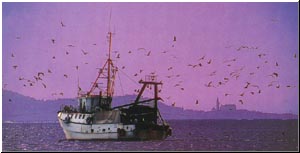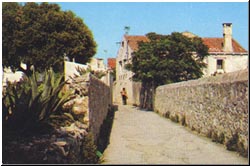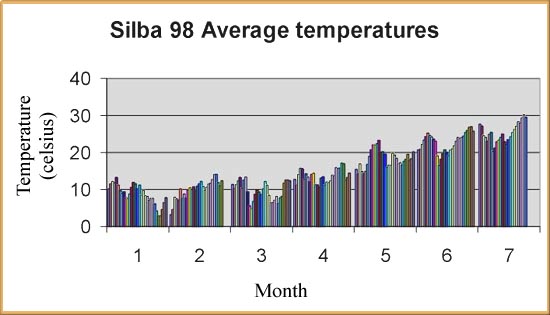


The Adriatic is ranked among the
warm seas. The surface temperature in summer
amounts to 23-25°C. The temperature of even the deepest waters is not below
11-13°C. At the depth of 70 metres the temperature is 18-19°C.
In winter, the surface temperature amounts to 14-16°C, and only exceptionally it falls
to l2°C. Then the southern Adriatic is warmer than the northern Adriatic. The
difference varies between 8°C and 10°C.
In spring the sea begins to get warmer and it soon reaches the temperature of
16-22°C. In summer- the sea is colder than the air and it prevents a more significant
warming. In winter being warmer than the air, the sea warms up the air. Thus it
moderates both summer and winter. One interesting point is that in total the sea is
warmer, than the air- by 1°C - 3°C.


The transparency is great, smaller close to the
shore, greater in the open sea. It is
the smallest in the northern Adriatic (5-39 meters), the greatest in the southern
Adriatic (16-56 metres). In the channels it reaches 10-30 metres. The colour of the
Adriatic,, sea is from light blue to deep blue, of a high intensity and various shades.
The water, is clear with an abundance of colours varying in the course of the day,
under the influence of the sun, the clouds and the winds, from, yellow, green, light
blue to deep blue, and together with a great transparency, it offers a memorable
experience.
In this clean and crystal-clear sea live 365 species of fish of which 112 species are
edible. Numerous families of mollusks, shells, sponges, algae and crabs live on the
seabed. One must not forget that this is the Mediterranean, which means that all of
them are of the highest quality and afford an inexpressible visual experience of
forms, colours and ways of living.

CLIMATIC CONDITIONS
ON THE ISLAND OF SILBA
(pdf download:72kb)
KLIMATSKI
UVJETI NA OTOKU SILBI
(pdf download:72kb)

The Adriatic has the Mediterranean
climate characterized by clear, warm and dry
summers and mild and humid winters. The transitional seasons spring
and autumn
have the characteristics of both summer and winter. The Adriatic is
often influenced
by different, often adverse, climatic and weather conditions. The
diversity and
frequent changes of the weather have a very favourable impact on the
life and
activities of the people and make the Adriatic ever more interesting
and more
attractive to those sailing it.
The temperature of the air is Mediterranean mild. The sea has a very
favourable
impact on the air temperature. In winter it warms up the air arriving
from the
mainland, and cools the hot air in summer. The mean air temperatures
the Adriatic
ranges from 14°C in the north to 18°C in the south which means the
progressing
south the temperature rises. In the northern area of the Adriatic
the mean
temperature is 2°C (the estuary of the PO) while the central and southern
parts it is
above 10°C.

On the east Croatian coast the temperature of the air is more than
2°C higher than on
the coast of southern France, and 3°C higher than on the west Adriatic,
the Italian
coast, though all the three are on the same latitude. In summer the
strong heat is
softened by the fresh sea-breeze, the "maestral". In summer,
in July, the mean
temperature ranges from 22 to 25°C. Autumns are warmer than springs.The
highest
temperature rarely surpasses 33°C-35°C, the lowest ones never falling
below 5°C.
On the sea and on the islands the differences in temperature are even
smaller, the
Iowest level only exceptionally falling below 0°C.

The Adriatic area ranks among the areas with the
highest rate of insolation. As
regards the summer clearness of the sky the central Dalmatian islands and the
southern part of the Croatian coast absolutely rank among the most clear-weather
regions of Europe. The central part of the Adriatic has the highest rate of insolation,
slightly higher on the open sea and on the islands than on the coast. Insolation in
hours per year are: Trieste 2205, Mali Losinj 2248, Sibenik 2572, Split 2697, Hvar
2715, Dubrovnik 2584.Insolation is at its highest in summer, at its lowest in winter.

Different parts of the Adriatic greatly differ
as regards the quantity of precipitation.
The mean quantities of precipitation per year vary from 420 mm in the open sea to
4626 mm in the elevated areas on the mainland. It is more abundant along the
coastline than on the islands and the open sea. Precipitation is most abundant in
autumn or winter. slightly Iess abundant in spring. Summer rains are very rare, with
the first rains in late August, and then usually associated with thunderstorms. Snow
on the Adriatic is a rarity. If snow does fall it does not keep on the ground. |